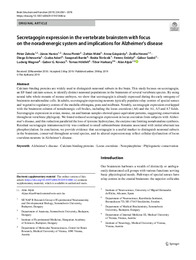Título :
Secretagogin expression in the vertebrate brainstem with focus on the noradrenergic system and implications for Alzheimer’s disease |
Autor :
Zahola, Péter
Hanics, János 
Pintér, Anna
Máte, Zoltán
Gáspárdy, Anna
Hevesi, Zsófia 
Echevarria, Diego 
Adori, Csaba 
Barde, Swapnali
Törőcsik, Beáta 
Erdélyi, Ferenc 
Szabó, Gábor 
Wagner, Ludwig 
Kovacs, Gabor G. 
Hökfelt, Tomas 
Harkany, Tibor
Alpár, Alán |
Editor :
Springer |
Departamento:
Departamentos de la UMH::Histología y Anatomía |
Fecha de publicación:
2019-05-29 |
URI :
https://hdl.handle.net/11000/34428 |
Resumen :
Calcium-binding proteins are widely used to distinguish neuronal subsets in the brain. This study focuses on secretagogin, an EF-hand calcium sensor, to identify distinct neuronal populations in the brainstem of several vertebrate species. By using neural tube whole mounts of mouse embryos, we show that secretagogin is already expressed during the early ontogeny of brainstem noradrenaline cells. In adults, secretagogin- expressing neurons typically populate relay centres of special senses and vegetative regulatory centres of the medulla oblongata, pons and midbrain. Notably, secretagogin expression overlapped with the brainstem column of noradrenergic cell bodies, including the locus coeruleus (A6) and the A1, A5 and A7 fields.
Secretagogin expression in avian, mouse, rat and human samples showed quasi-equivalent patterns, suggesting conservation throughout vertebrate phylogeny. We found reduced secretagogin expression in locus coeruleus from subjects with Alzheimer’s disease, and this reduction paralleled the loss of tyrosine hydroxylase, the enzyme rate limiting noradrenaline synthesis. Residual secretagogin immunoreactivity was confined to small submembrane domains associated with initial aberrant tau phosphorylation. In conclusion, we provide evidence that secretagogin is a useful marker to distinguish neuronal subsets in the brainstem, conserved throughout several species, and its altered expression may reflect cellular dysfunction of locus coeruleus neurons in Alzheimer’s disease.
|
Palabras clave/Materias:
Alzheimer’s disease
Calcium-binding proteins
Locus coeruleus
Norepinephrine
Phylogenetic conservation |
Tipo de documento :
info:eu-repo/semantics/article |
Derechos de acceso:
info:eu-repo/semantics/openAccess
Attribution-NonCommercial-NoDerivatives 4.0 Internacional |
DOI :
10.1007/s00429-019-01886-w |
Publicado en:
Brain Struct Funct . 2019 Jul;224(6):2061-2078 |
Aparece en las colecciones:
Artículos Histología y Anatomía
|

 La licencia se describe como: Atribución-NonComercial-NoDerivada 4.0 Internacional.
La licencia se describe como: Atribución-NonComercial-NoDerivada 4.0 Internacional.
.png)